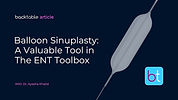BackTable / ENT / Podcast / Episode #137
Balloon Sinuplasty: Evolution, Efficacy & Expert Insights
with Dr. Ayesha Khalid
In this episode of BackTable ENT, Dr. Gopi Shah and Dr. Ayesha Khalid, rhinologist with Cambridge Health Alliance in Massachusetts, discuss balloon sinuplasty indications, techniques, and post-operative management.
This podcast is supported by:
Be part of the conversation. Put your sponsored messaging on this episode. Learn how.

BackTable, LLC (Producer). (2023, October 24). Ep. 137 – Balloon Sinuplasty: Evolution, Efficacy & Expert Insights [Audio podcast]. Retrieved from https://www.backtable.com
Stay Up To Date
Follow:
Subscribe:
Sign Up:
Podcast Contributors
Dr. Ayesha Khalid
Dr. Ayesha Khalid is the chief of the ENT division at Cambridge Health Alliance in Massachusetts.
Dr. Gopi Shah
Dr. Gopi Shah is a pediatric otolaryngologist and the co-host of BackTable ENT.
Synopsis
First, Ayesha reviews the history of balloon sinuplasty. Originally used in cardiology, otolaryngologists adopted balloons as a less-invasive option to widen sinus ostia. Over time, balloon sinuplasty transitioned from being an operative procedure to one that can be done in-office with select patients. In Ayesha’s experience, facial pain and nasal stuffiness are the symptoms most responsive to balloon sinuplasty.
Then, the conversation shifts to application of balloon technology. Rather than thinking about balloon procedures and traditional functional sinus surgery as mutually exclusive, Ayesha sees them as complementary tools. Patients with straightforward sinusitis or barotrauma often improve with an in-office balloon procedure and sinus rinses. When scheduling an in-office balloon procedure, Ayesha counsels on the odds of success (over seventy percent) and possible need for further surgery. For example, patients with polyp disease might be better suited to a more traditional sinus surgery. Even in these cases, Ayesha uses balloons to widen ostia, as they inflict less trauma than traditional sinus instrumentation. Ayesha then walks listeners through her preparation for and performance of an in-office balloon procedure.
Finally, Ayesha fits balloon sinuplasty into the larger context of sinusitis treatment. She emphasizes the importance of sinus rinses for sinusitis patients both pre-and post-operatively. She sees patients one week, one month, and then three months following any balloon procedure. Depending on the nature of their disease, patients sometimes require steroids or biologics after their balloon, but most report improvement of their sinus symptoms. Ayesha leaves listeners with advice on expanding one’s procedural toolkit as a practicing ENT.
Transcript Preview
[Dr. Ayesha Khalid]
I think that while we're here talking about balloon sinuplasty, we're really talking about the fact that sinusitis and inflammatory disease continues to be complex for ENTs, continues to be something that patients come to see us for that many of us still have trouble solving. I would argue that, as much as I love being a rhinologist, I think being an otolaryngologist, anyone and everyone should feel comfortable starting to expand and use all the tools that are at your disposal. My goal is to say it's not mysterious, it's just comfort, practice, like anything else. Having some mentors, friends, colleagues. Balloon sinuplasty is just one of the options.
Disclaimer: The Materials available on BackTable.com are for informational and educational purposes only and are not a substitute for the professional judgment of a healthcare professional in diagnosing and treating patients. The opinions expressed by participants of the BackTable Podcast belong solely to the participants, and do not necessarily reflect the views of BackTable.














